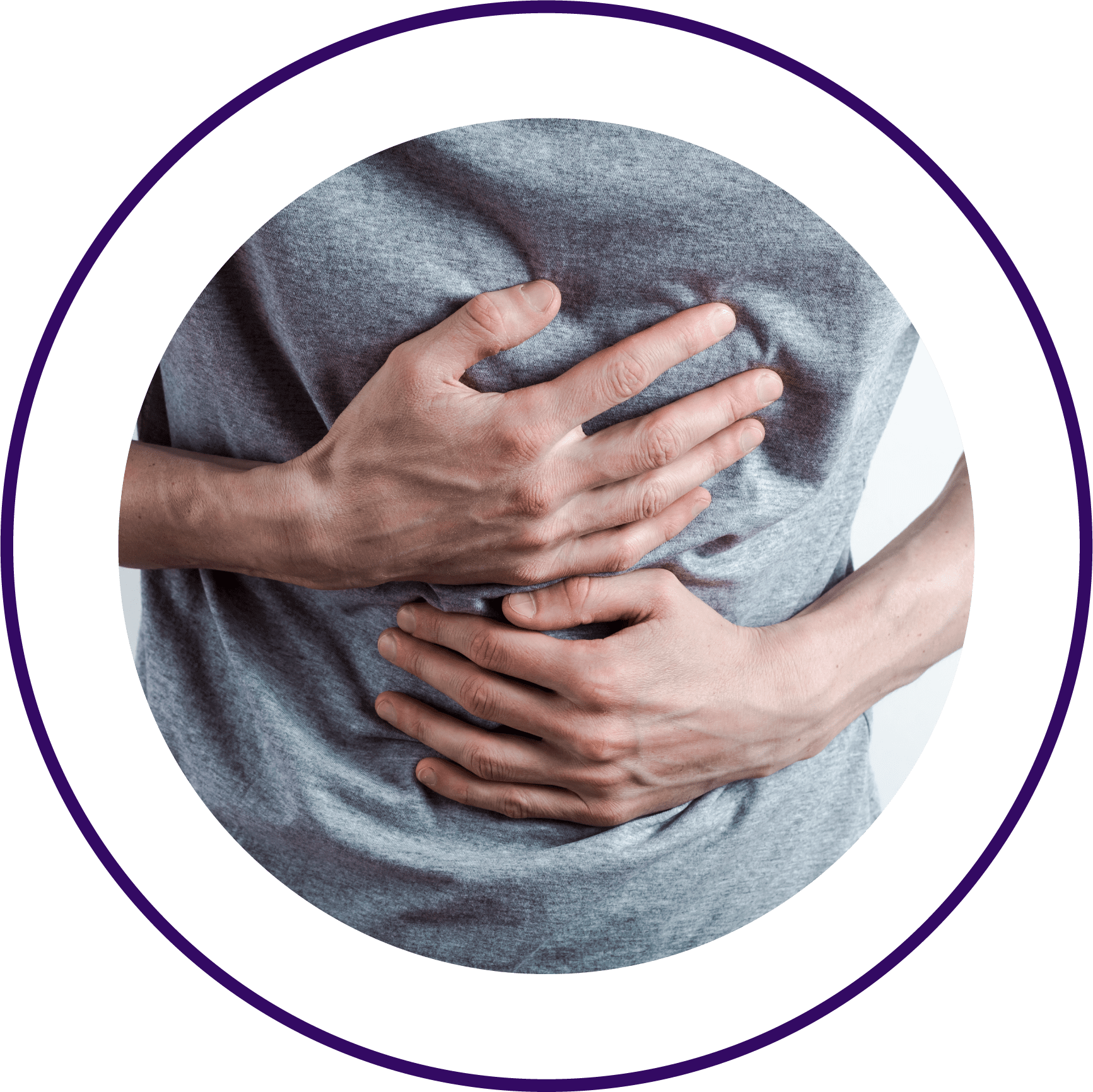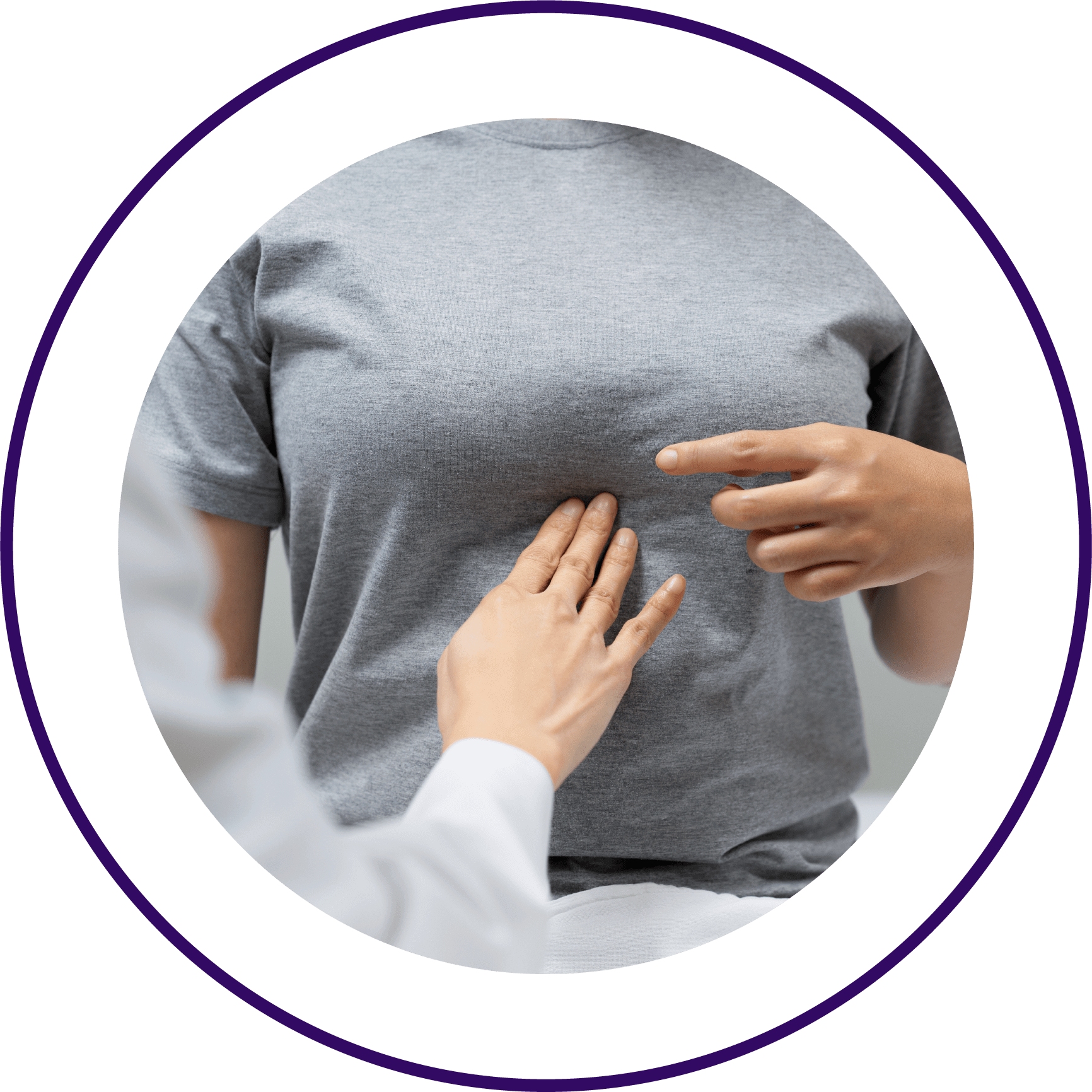Understanding Epigastric ‘stomach’ pain

Epigastric ‘stomach’ pain
Epigastric pain is one of the most common presenting symptoms or complaints that doctors come across on a daily basis[i]. There is however a broad spectrum of causes for the epigastric pain and getting to the brunt of the cause can be challenging. Epigastric pain is not, however, always a reason for concern and certain conditions are easily treatable. Therefore, determining what’s causing the pain is important to find the best and easiest way to treat and release the pain, in the shortest period of time[ii],3,4. In this blog we will briefly discuss the various causes and how to distinguish and test for them.
What is epigastric pain?
Your epigastrium / epigastric region is located just below the sternum and is the upper part of the abdomen in the midline of your body2,[i],[ii],[iii]. Pain in this region may be felt as a deep burning sensation often described as heartburn. Triggering factors for worsening pain may be eating or lying down3,4,5.
Several other symptoms may accompany the pain which helps determine the possible cause. Evaluating the combined symptoms with epigastric pain will help your doctor choose the correct test to help diagnose the cause and give the appropriate treatment.

What other symptoms can present with epigastric pain?
Other symptoms that may accompany epigastric pain include2,3,4,5:
- Abdominal discomfort or bloating
- Nausea
- Vomiting
- Diarrhoea
- Pain in the upper chest
- Constipation
- Flatulence
More serious or life-threatening conditions can be associated with2,3,4,5:
- Chest pain, tightness or palpitations
- Pain radiating down your arm
- Difficulty breathing
- Vomiting blood or black substance
- Sudden excessive weight loss
It is, therefore, crucial to try and give your doctor as much information as possible about your symptoms and/or condition to help them determine what is going on.
Causes and diagnosis of epigastric pain
1. Indigestion (dyspepsia)
The most common cause of epigastric pain is indigestion. Indigestion often occurs with over-eating, combining alcohol with food or eating rich, spicy or greasy foods. Bloating and nausea may also be associated.
Indigestion is a clinical diagnosis and is usually managed with antacids. Indigestion may also occur if one is lactose intolerant. A trial of eliminating certain foods that contain lactose may aid in managing the pain. Diet and lifestyle changes may also assist in reducing pain2,3,4,5.
2. Acid reflux and gastro-oesophageal reflux disease (GORD)
Acid reflux occurs when stomach contents tend to push back up the oesophagus and cause burning sensations in the epigastrium and chest. This may lead to a burning sensation in the chest, bitter taste in your mouth, indigestion, throat pain or hoarseness and chronic coughing. The pain may be worsened by eating or when lying down. The pain is usually responsive to antacids2,3,4,5.
Ongoing or persisting acid reflux may lead to gastro-oesophageal reflux disease, which requires more monitoring and treatment2,3,4,5.
GORD can be evaluated using specialized x-ray screening techniques such as a Barium swallow, where once swallowing the Barium fluid, the direction the Barium moves can be monitored on the x-ray screen.
3. Gallbladder disease
Epigastric pain may occur when your gallbladder is inflamed, a condition known as cholecystitis. Cholecystitis usually occurs in association with gallstones in the gallbladder. The pain may be associated with decreased appetite, nausea and vomiting, worsening pain with eating, bitter taste in the mouth, right shoulder and/or back pain, fever, jaundice and clay coloured stools. Gallstones with cholecystitis may result in the gallbladder needing to be removed2,3,4,5.
Ultrasound is the imaging modality or test of choice to evaluate for gallstones or cholecystitis and is the quickest and cheapest test to rule out the difference between organ causes or gastrointestinal causes.
Gallstones are seen on ultrasound as bright white structures/balls with strong black shadowing behind them. They are usually mobile in the gallbladder. Cholecystitis can be seen on ultrasound as thickening of the gallbladder wall after a fasting period2,[i].
Other gallbladder diseases that may be associated with epigastric pain include gallbladder cancer, gallbladder polyps, or gallbladder disease from other obstructive causes2.
4. Pancreas disease (pancreatitis/pancreas cancer)
Pancreatitis is inflammation of the pancreas which may be acute (sudden onset) or chronic (continuous inflammation for a period of time). It is often associated with sudden pain in the back and vomiting.
Pancreatic cancer should be considered if the pain is associated with sudden weight loss, new onset of diabetes or unexplained epigastric pain2,3,4[i],[ii].
Ultrasound is usually the first imaging modality to visualize the pancreas, as it is useful when screening for growths such as cancer or visualizing pancreatitis.
Ultrasound does, however, have its limitations with visualizing the pancreas due to stomach and bowel gas shadowing and other technical factors. In these instances, computed tomography also known as a CT scan is the modality of choice to visualize and diagnose pancreas diseases. Magnetic resonance imaging or MRI is also a specific imaging technique for accurate diagnosis and evaluation. CT scans and MRI’s are especially useful to determine the extent and spread in the case of cancer2,8.
5. Hiatus hernia
A hiatus hernia occurs when the top part of the stomach pushes into the chest through the hole in the diaphragm where the oesophagus passes through, which is known as the hiatus. A hiatus hernia does not always cause pain but may be associated with indigestion, burning chest, throat pain and hoarseness and loud burping3,4,5,6,[i].
A hiatus hernia may be detected on a plain chest x-ray, however other specialized imaging modalities such as Barium swallow screening or a CT scan may be needed to evaluate the extent of the disease9.
6. Heart attack/angina
Heart attack symptoms other than that of epigastric pain may include shortness of breath, pain and tightness of the chest, nausea, indigestion and heartburn, dizziness and pain in the left or right arm. This is a medical emergency and needs quick diagnosis and monitoring[i].
A heart attack may be diagnosed during an electrocardiogram. Doctors will need to assess what caused the attack and may order additional tests such as a heart ultrasound, CT scan or MIBI Scan.
7. Mesenteric adenitis
Is a condition more commonly found in children and is caused by swelling of lymph nodes in the mesenteric lining of the stomach usually due to bacterial or viral infections5.
The swollen lymph nodes can easily be detected using high-frequency ultrasound techniques.
8. Gastric/stomach cancer
This diagnosis should be considered especially in men over 55 years of age and smokers. Some of the distinguishing factors include sudden weight loss, vomiting, palpated masses and other associated symptoms depending on the stage of cancer.
Other conditions that may also occur with epigastric pain include peptic ulcers, Barret’s disease, esophagitis or gastritis3,4,5,6,7.
If you are experiencing any of the epigastric pain symptoms in our article, consult with your doctor. Visit any of our multi-locational practices for any imaging required in your diagnosis and management.
Make your booking at 087 055 0587 or info@ks-med.co.za.
Make a booking
Need to get a scan done?
REFERENCES
- Robinson P, Perkins JC. Approach to patients with epigastric pain. Emergency Medicine Clinics. 2016 May 1;34(2):191-210.
- Sanders RC, Winter TC, editors. Clinical sonography: a practical guide. Lippincott Williams & Wilkins; 2007.
- Healthgrades.com [Internet]. Epigastric Pain. Healthgrades Operating Company Inc., [Updated 2018 December 28; Cited 23 February 2020]. Available from: https://www.healthgrades.com/right-care/digestive-health/epigastric-pain
- Healthline.com [Internet]. What’s causing my epigastric pain and how can I find relief. Healthline Media a Red Venture company. [Updated 2017 June 12; Cited 2020 February 20].Retrieved from: https://www.healthline.com/health/epigastric-pain#see-your-doctor
- Patient.info [Internet] Epigastric Pain. Patient Platform ltd. [Updated 2018 March 22; cited 2020 February 23] Retrieved from: https://patient.info/doctor/epigastric-pain
- Radiopaedia.org [Internet]. Gallstones. Radiopaedie.org. [Updated unknown; cited 2020 February 2020]. Retrieved from: https://radiopaedia.org/articles/gallstones-1
- Radiologykey.com [Internet]. Epigastric pain. [Updated 2016 August 27, Cited 2020 February 23]. Retrieved from: https://radiologykey.com/epigastric-pain/
- Radiopaedia.org [Internet]. Acute pancreatitis. Radiopaedia.org [Updated 2020 January; Cited 2020 February 23]. Retrieved from: https://radiopaedia.org/articles/acute-pancreatitis
- Radiopaedia.org [Internet]. Hiatus Hernia. Radiopaedia.org. [Updated 2018; Cited 2020 February 23]. Retrieved from: https://radiopaedia.org/articles/hiatus-hernia
- Mayoclinic.org [Internet]. Heart attack. Mayo Foundation for medical education and research. [Updated 2018 May 30, Cited 2020 February 23]. Retrieved from: https://www.mayoclinic.org/diseases-conditions/heart-attack/symptoms-causes/syc-20373106
